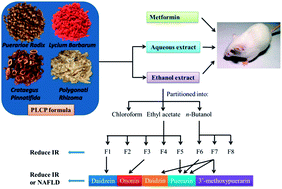A diet formula of Puerariae radix, Lycium barbarum, Crataegus pinnatifida, and Polygonati rhizoma alleviates insulin resistance and hepatic steatosis in CD-1 mice and HepG2 cells
Abstract
According to the principles of traditional Chinese medicine, medicinal and edible herbs exhibit holistic effects through their actions on multiple target organs. Four herbs, Puerariae radix, Lycium barbarum, Crataegus pinnatifida, and Polygonati rhizoma, were selected and combined to create a new herbal formula (PLCP). The protective effects of both the aqueous extract (AE) and ethanol extract (EE) of PLCP against insulin resistance (IR) and non-alcoholic fatty liver disease (NAFLD) were evaluated in both high fat and high fructose diet-fed mice. Active fractions and constituents were screened in HepG2 cells with IR or an over-accumulation of triglycerides, and were further identified by high-performance liquid chromatography/electrospray ionization/mass spectrometry. The results indicate that the AE did not improve (p > 0.05) glucose tolerance after three weeks, whereas EE showed a promising effect throughout the experiment. Medium and high doses of EE were found to reduce fasting blood glucose at week 9 by 21.1% and 24.4%, respectively. In addition, their efficacies for alleviating IR were comparable with that of metformin. Compared with AE, EE effectively improved hyperlipidemia, antioxidant status, and NAFLD. In contrast, metformin did not alleviate hyperlipidemia (p > 0.05) or NAFLD in the mice model. Results from the cell-based study indicate that the protective effects of EE were possibly due to the actions from puerarin, 3′-methoxypuerarin, daidzin, daidzein, and ononin.


 Please wait while we load your content...
Please wait while we load your content...